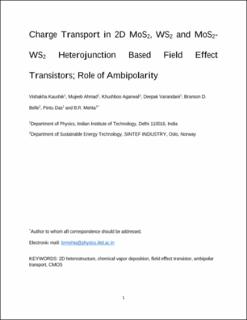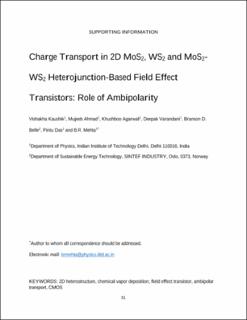| dc.contributor.author | Kaushik, Vishakha | |
| dc.contributor.author | Ahmad, Mujeeb | |
| dc.contributor.author | Khushboo, Agarwal | |
| dc.contributor.author | Varandani, Deepak | |
| dc.contributor.author | Belle, Branson | |
| dc.contributor.author | Das, Pintu | |
| dc.contributor.author | Mehta, Bodh R. | |
| dc.date.accessioned | 2022-09-19T13:43:29Z | |
| dc.date.available | 2022-09-19T13:43:29Z | |
| dc.date.created | 2020-10-30T11:11:17Z | |
| dc.date.issued | 2020 | |
| dc.identifier.citation | Journal of Physical Chemistry C. 2020, 124 (42), 23368-23379. | en_US |
| dc.identifier.issn | 1932-7447 | |
| dc.identifier.uri | https://hdl.handle.net/11250/3018965 | |
| dc.description.abstract | Electrical and optical characteristics of few-layered (3–4 L) chemical vapor deposition (CVD) grown MoS2, WS2, and MoS2–WS2 heterostructure-based back-gated field-effect transistor (FET) devices have herein been studied. The structure, stoichiometry, and work function of the two-dimensional (2D) materials that comprise the channel region have been comprehensively characterized. The MoS2 device exhibits a unipolar n-type behavior with a high field-effect ON/OFF ratio (>103) and a low subthreshold swing of 668 mV/decade at room temperature. WS2 and MoS2–WS2 heterostructure devices exhibit gate driven ambipolarity due to chemically active defect sites, offering precise control on the carrier type necessary for realization of logic devices. Record-high room-temperature electron mobility (19 cm2/V.s) exhibited by the MoS2–WS2 heterostructure device displays an improved electrical performance of almost one order of magnitude higher than already existing 2D devices. The prototype of a 2D complementary metal–oxide–semiconductor (CMOS) logic inverter switch integrating high electronic and optical responses of the MoS2–WS2 heterostructure junction owing to ambipolar FET operation has been demonstrated. The achieved results encompassing superior photoabsorption, atomically thin thickness, and high performance indices suggest that soft 2D heterostructure devices may open a new paradigm in artificial retinal implants and photoelectronics. | en_US |
| dc.language.iso | eng | en_US |
| dc.publisher | ACS | en_US |
| dc.subject | Halvledere | en_US |
| dc.subject | Semiconductors | en_US |
| dc.subject | 2D materialer | en_US |
| dc.subject | 2D materials | en_US |
| dc.title | Charge Transport in 2D MoS2, WS2, and MoS2–WS2 Heterojunction-Based Field-Effect Transistors: Role of Ambipolarity | en_US |
| dc.type | Peer reviewed | en_US |
| dc.type | Journal article | en_US |
| dc.description.version | acceptedVersion | en_US |
| dc.rights.holder | © American Chemical Society 2020. This is the authors accepted and refereed manuscript to the article. | en_US |
| dc.source.pagenumber | 23368-23379 | en_US |
| dc.source.volume | 124 | en_US |
| dc.source.journal | Journal of Physical Chemistry C | en_US |
| dc.source.issue | 42 | en_US |
| dc.identifier.doi | https://doi.org/10.1021/acs.jpcc.0c05651 | |
| dc.identifier.cristin | 1843558 | |
| dc.relation.project | Norges forskningsråd: 280788 | en_US |
| dc.relation.project | Norges forskningsråd: 245963/F50 | en_US |
| cristin.ispublished | true | |
| cristin.fulltext | postprint | |
| cristin.fulltext | postprint | |
| cristin.qualitycode | 1 | |

